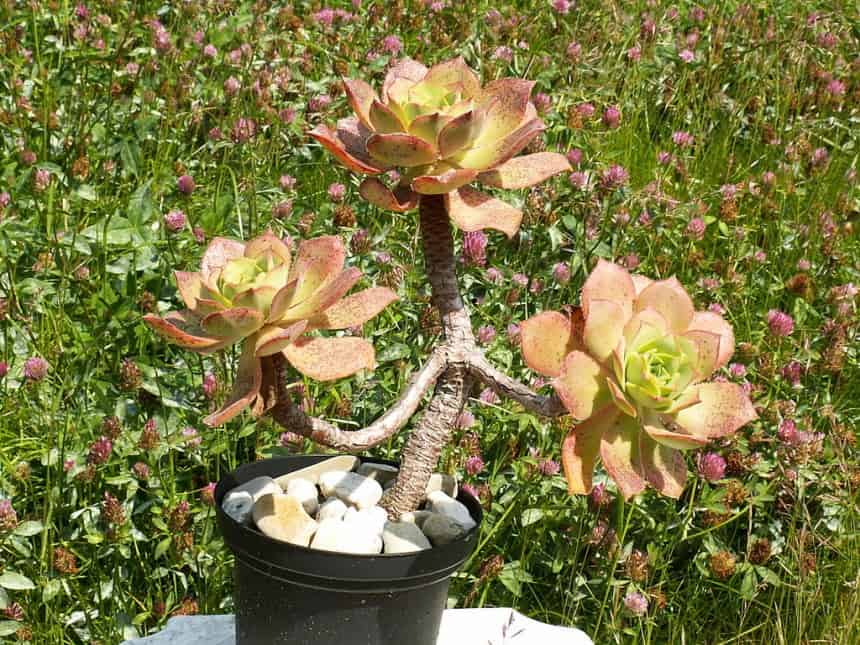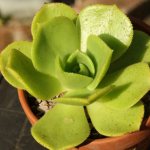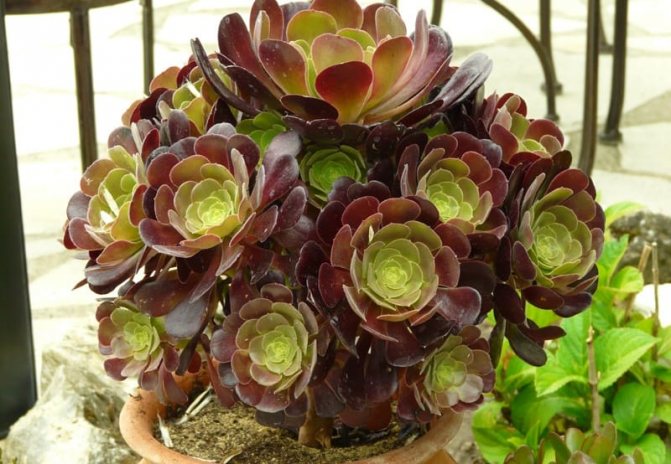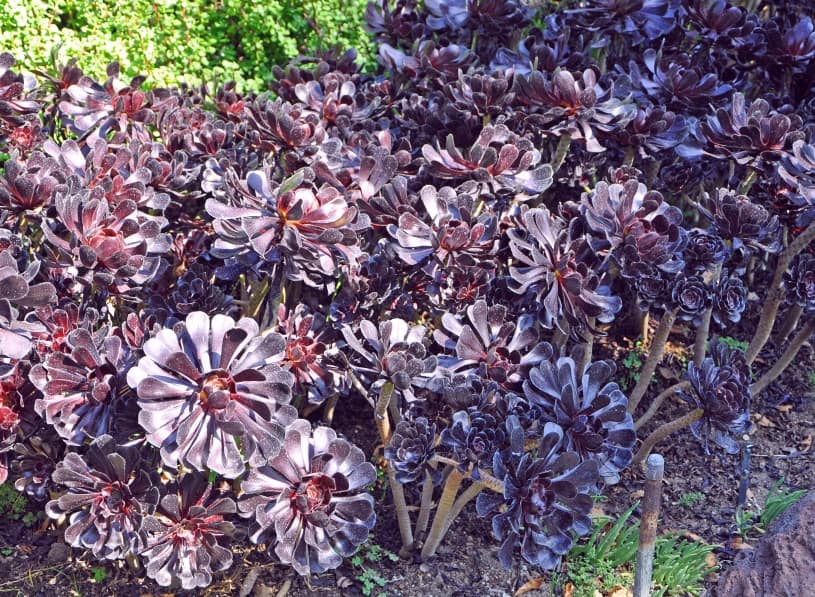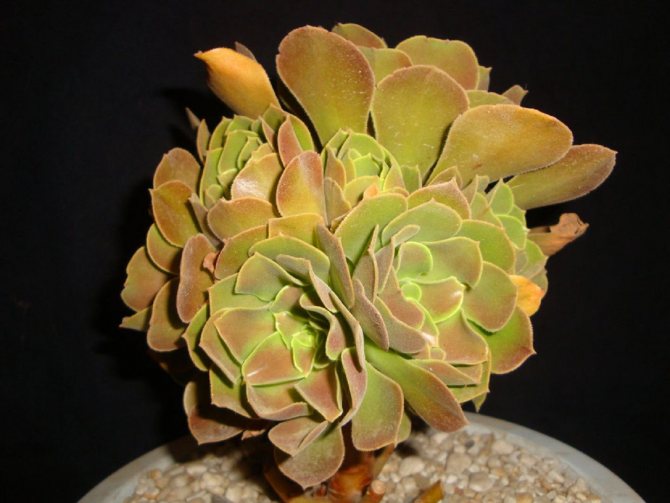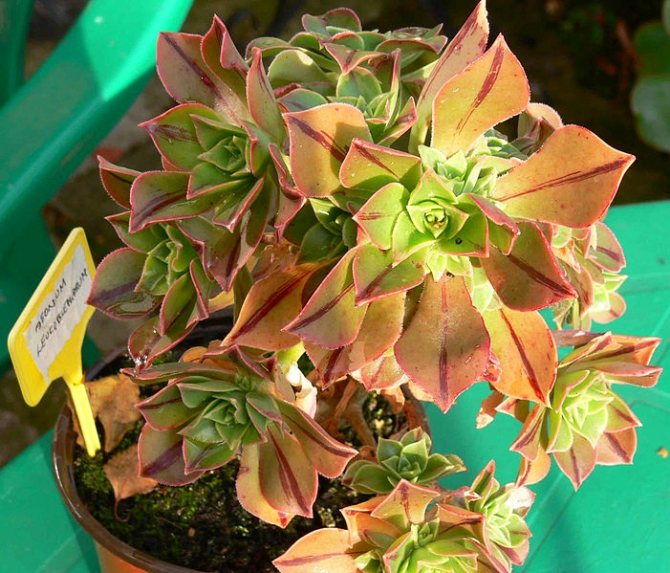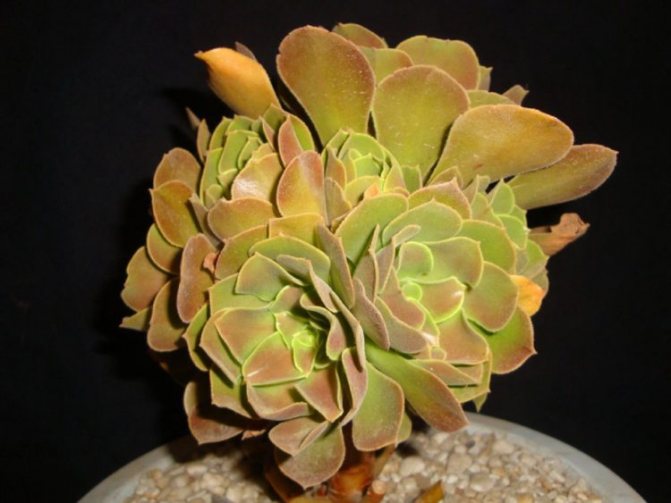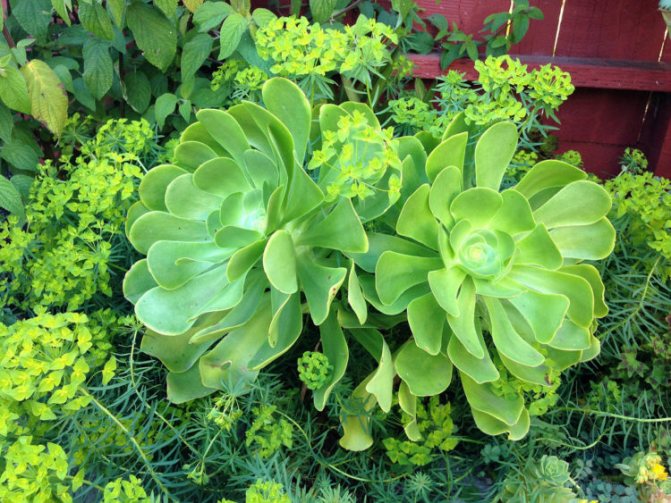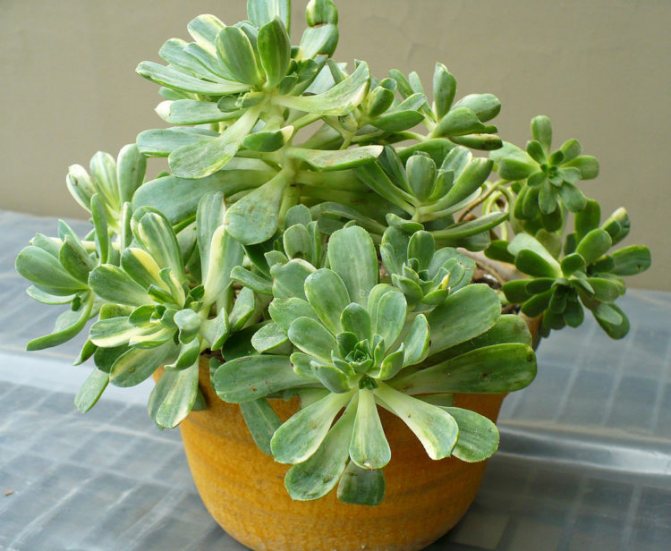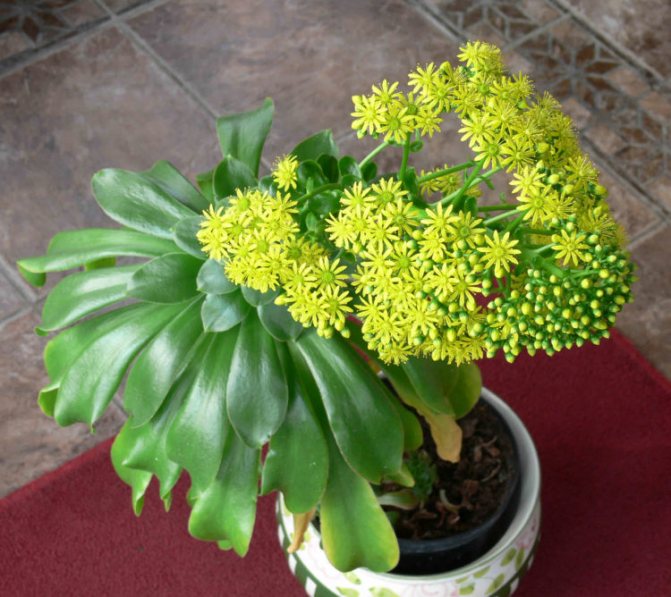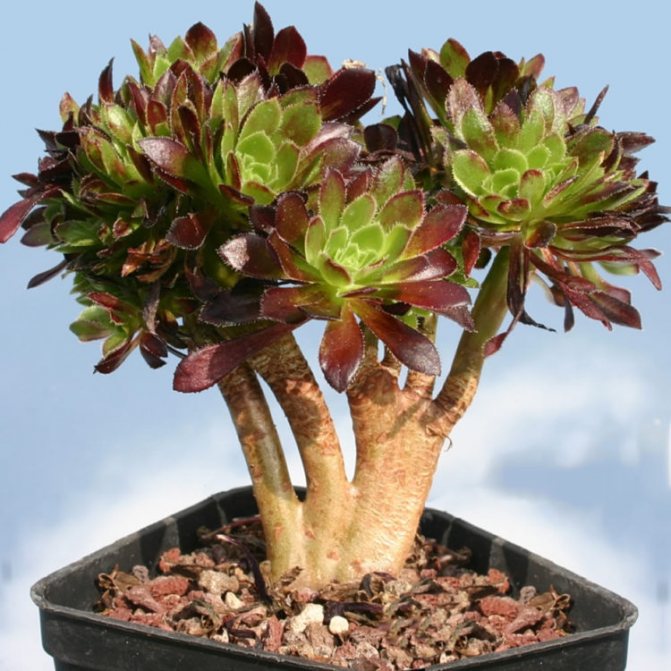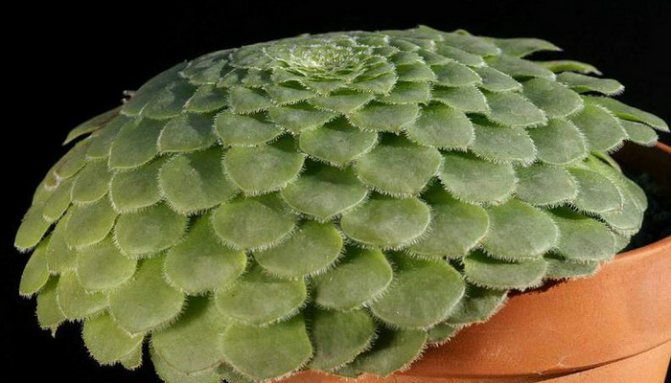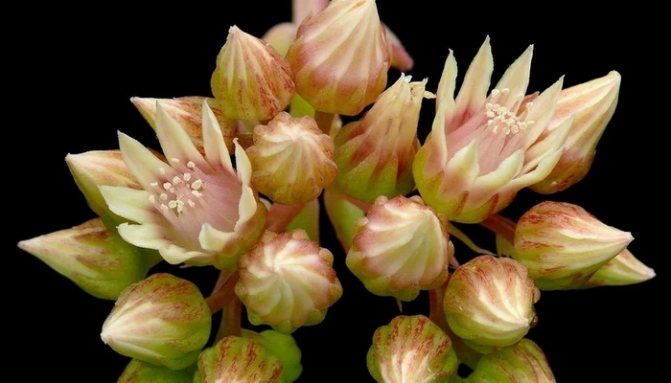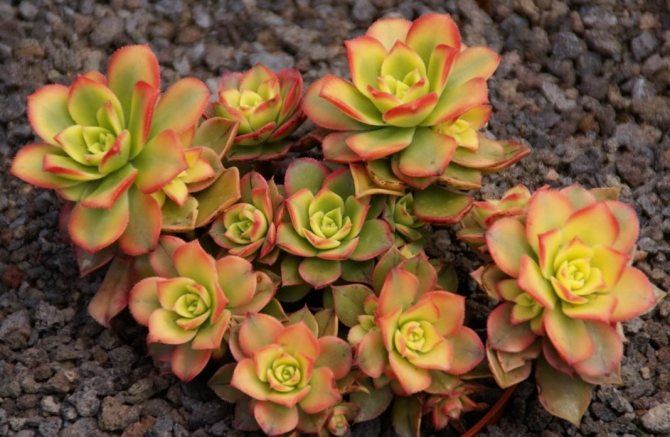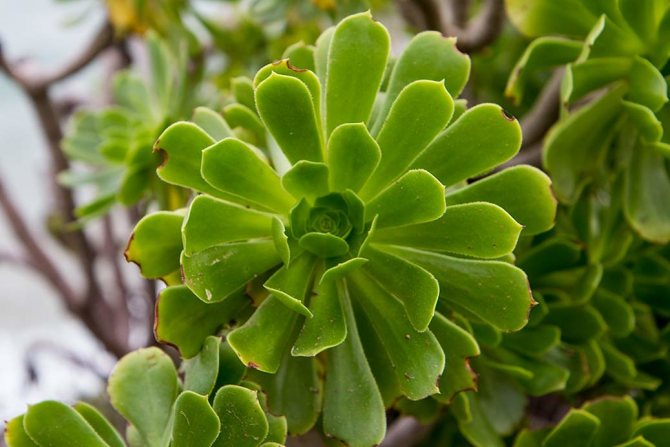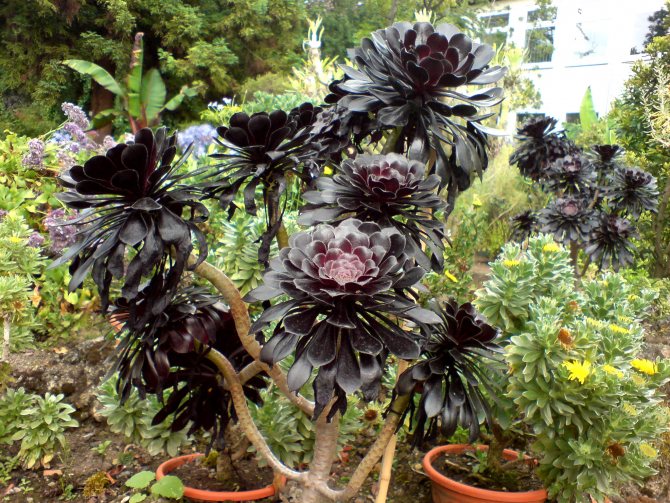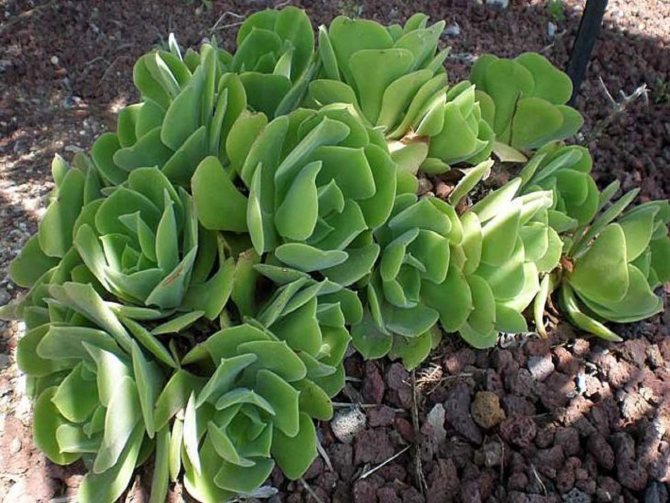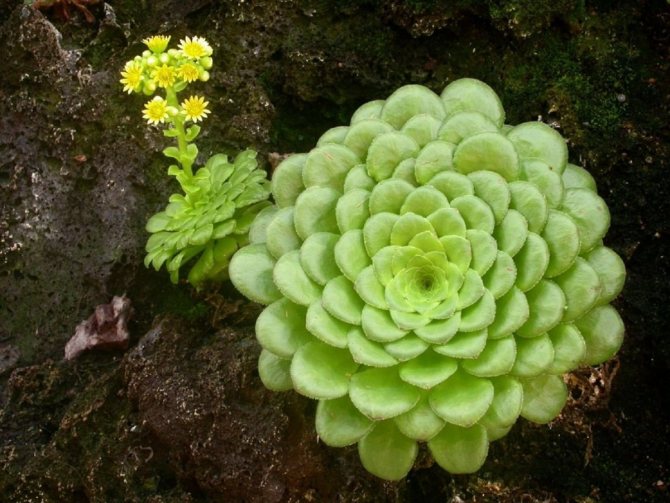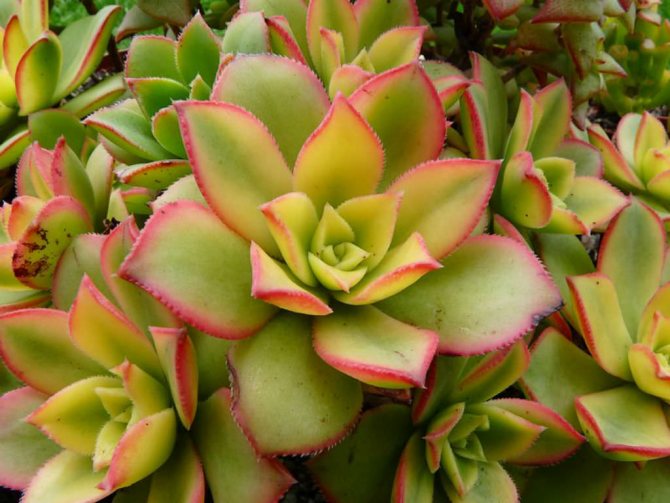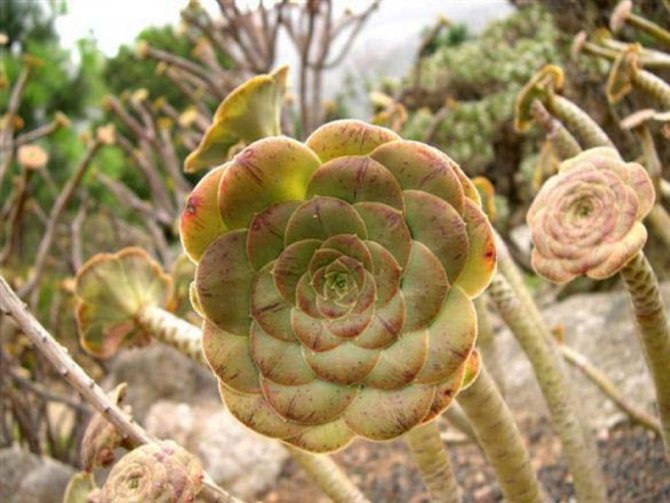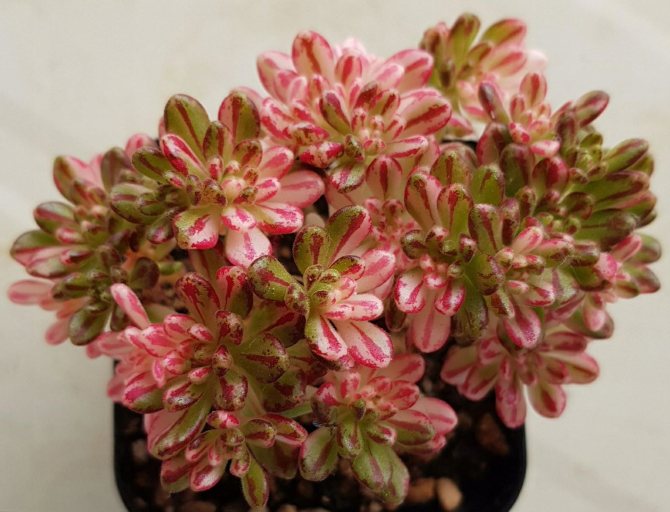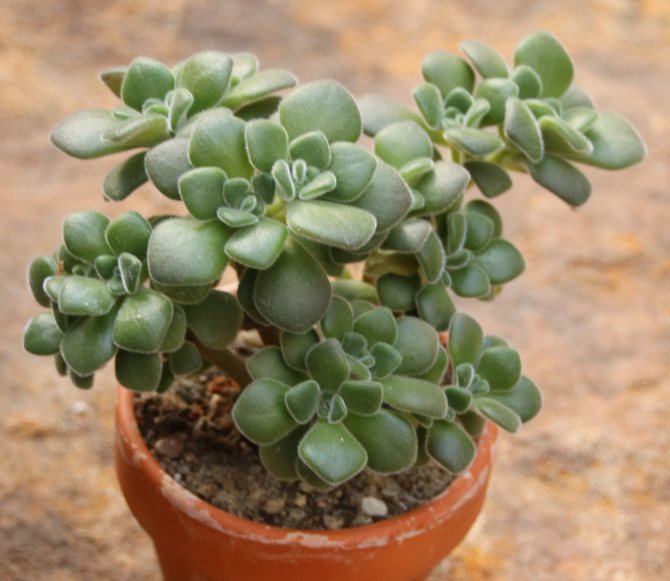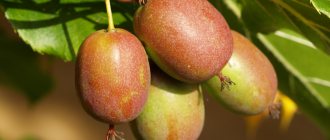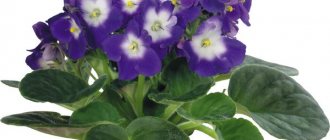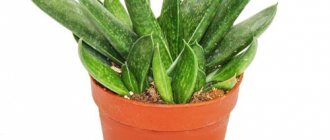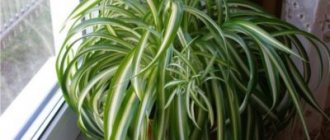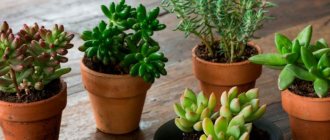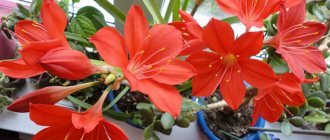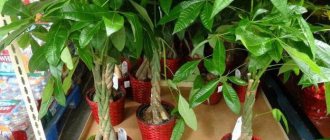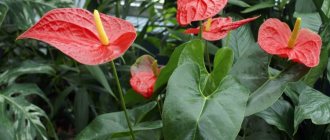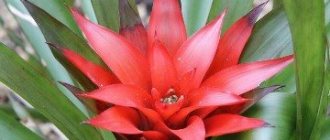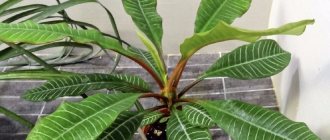The rosette formed by large fleshy leaves resembles large fantastic flower, surpassing the real bud in beauty.
Such a "flower" delights the owners all the time, without risking to crumble.
Description and photo of the flower
Aeoniums are perennial unpretentious plants of the fat family... There are about 40 species. They have small stems and rosettes of dense leaves.
In the spring-summer period, aeonium has small flowers collected in inflorescences.
At home, succulent blooms very rarely.
Below you will see a photo of the plant:
General characteristics
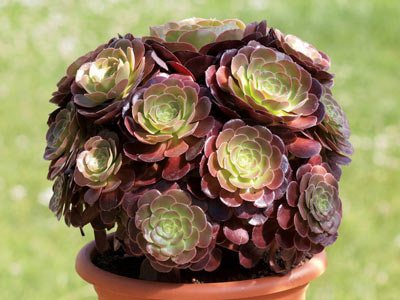
A plant from the Tolstyankovye family is considered a long-liver, according to the translation of the name "aeonium".
Height ranges from 5 to 60 cm.
The long fleshy stems are covered with leafy rosettes, the diameter of which can reach 60 cm.
Every year, when new leaves are added, the lower leaf plates die off - the central shoot lengthens. Eonium possesses well-developed branched root system underground and aerial rootsformed in places where the leaf is attached to the shoot.
The ground part stands out for its fleshiness. The green, red, brown or purple leaves of a diamond-shaped or oval shape have significantly narrowed bases in comparison with the edges. Smooth, dense or slightly drooping skin on the leaf plate does not allow moisture to evaporate.
Before flowering at the end of the stem an erect fleshy peduncle developshaving lateral branches. It is crowned with a pyramidal inflorescence of yellow, white or red flowers. Sometimes the inflorescence resembles a miniature tree growing from the central part of an unusual disc.
Monocarpity of succulent is manifested in his death after the end of flowering... When a plant has several shoots, then it can survive: if only the shoot on which there was a peduncle dries up.
How to care for a plant?
Caring for the aeonium has its own characteristics, knowing and taking into account them, you can grow a blooming tropical succulent.
Lighting
The plant is very light-requiring.
The flower is illuminated throughout the year, even during the dormant period, which is observed in winter. To do this, it is recommended to install phytolamps with the onset of cold weather.
In the summer, the aeonium is taken out into the fresh air (garden, balcony). The plant can be placed in direct sunlight, they will not harm it in any way. In insufficient light, the leaves turn pale and stretch.
The duration of daylight hours throughout the year for a flower should be 9-12 hours.
Temperature
A suitable temperature for growing aeonium in spring and summer is 19-25 degrees. An increased temperature leads to an increase in the sensitivity of the leaves, and a low temperature negatively affects the condition of the flower.
In winter, the temperature is reduced to 10-12 degrees, you can put a pot with a plant on a warmed or heated balcony. This is necessary for the succulent to gain strength and feel natural processes. but aeonium adapts well to ordinary room conditions.
Location
The succulent plant should be placed on southern or southeastern windowsills. In summer, take out to the balcony or garden. Protect from sunlight only on a very hot day. North windows are not suitable for growing a plant.
Watering
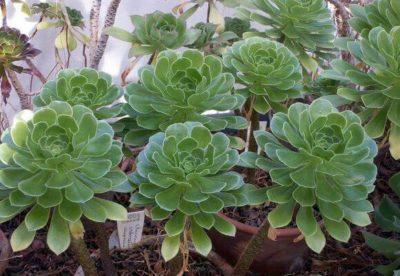

There is no special attention to watering the aeonium, the main thing is to make sure that the earth does not dry out. Succulents do not need a lot of moisture even during the flowering period..
The soil should dry out between waterings. In the summer, the procedure is carried out once a week. In winter, even less than once every 2-3 weeks.
Water the plant very carefully along the edge of the pot. Do not allow water to enter the rosettes of the trunk and leaves, as well as the accumulation of moisture in the center of the inflorescence.
Stagnation of water is unacceptable, as this can lead to decay and the appearance of molds, and hence the death of the flower. therefore it is recommended to spud the succulent before watering.
Air humidity
The plant tolerates dry weather well, so the humidity of the air is not so important for the flower. Spraying the succulent or wiping with a damp cloth is done occasionally to remove dust on outlets and leaves. For spraying, running water at room temperature is suitable.
For hygienic purposes, you can arrange a warm shower... In this case, the substrate in the pot is covered with cellophane from water ingress.
For a comfortable life of a flower, the room where it is located must be ventilated, since it needs fresh air, but it is worth making sure that there are no drafts and sudden temperature changes.
Top dressing
Young aeoniums are not fertilized. Adult plants need feeding only during the period of active growth from spring to summer. Fertilization for a flower is carried out 1 time in 2-3 weeks. Use fertilizer for cacti and other succulents with a high potassium content.
If white spots appear on the leaves of the plant, then this indicates an excess of minerals. If white spots appear, the dose of feeding should be reduced by 2 times..
The soil
The soil should be loose and neutral in acidity. Purchased cactus soil works well. But you can cook it yourself.
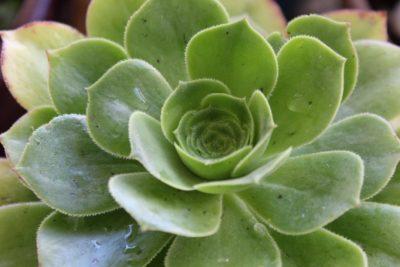

For this, leafy, clay and soddy lands, as well as sand, are combined in equal shares. A small amount of crushed charcoal is also poured into the ground. Charcoal helps prevent root rot.
When planting, a good drainage layer of expanded clay should be made. The pot cannot be taken for growth, since the soil in it will not dry out for a long time. And the land between waterings should dry out completely. From spring to autumn, the aeonium is watered as the soil dries up. Plants react poorly to excess moisture in the ground and to water that gets into the rosettes of leaves. In winter, eonium is watered once a month, not more often. Since the aeonium is drought-resistant, it is not necessary to spray the plant.
Pruning
Eonium tolerates pruning well... In early spring, when long or curved shoots appear, their crown is cut off with a sharp knife. Subsequently, they are used for rooting. It is recommended to sprinkle the cut with activated carbon. Then new sockets will grow in this place. And also remove yellowed leaves.
Application in traditional medicine
Eonium has unique healing properties: the plant absorbs the affected skin while remaining safe for healthy tissue... For confirmation, a succulent leaf was bandaged to healthy skin overnight.
In the morning, a leaf with a slight bump and unchanged skin were found. The next night, the leaf blade was fixed on the corn. When the bandage was removed in the morning, the sheet was missing, and instead of a callus, a small trace was found.
The medicinal properties of sap and leaves of the culture have been known in alternative medicine for a long time. Eonium is used to treat the following diseases:
- Cataract and glaucoma. Instillation is carried out three times a day with freshly squeezed juice, 1-2 drops in each eye.
- Diabetes.To normalize blood sugar levels, 2 leaves of the plant are eaten every day.
- Wounds, burns. When applying a compress, the healing of damaged tissue is accelerated.
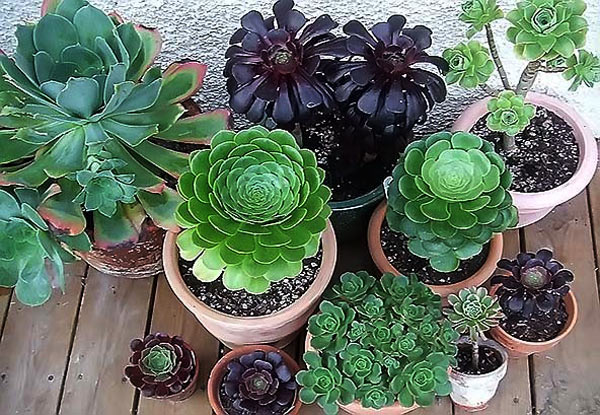

So, aeonium combines aesthetic beauty and useful properties. At the same time, the owner of a unique flower does not spend a lot of time and effort on creating comfortable growing conditions for him.
Reproduction
Succulent propagates in the following ways:
- Apical rosette... Take a stem with a rosette of leaves, dry it for 2-3 days in a cool place protected from the sun. Then they are planted in moist soil. Water in moderation.
Until the roots come out, the flower should not be placed in direct sunlight. The plant takes root within 2-3 weeks. - Cuttings of leaves... After drying, the leaves are simply placed in a pot with a substrate, without digging into the ground.
- Seeds... They are scattered over the surface of the earth, without falling asleep with soil. Then it is sprayed with a spray bottle and covered with a glass jar. At a temperature of 20 ° C, seeds germinate easily. Overheating or overcooling is not recommended.
Reproduction of aeonium at home
In floriculture, two methods of cultivation are common:
- seminal;
- vegetative.
Seed breeding
A time consuming method that a passionate florist can apply.
- The seeds are poured onto the surface of the soil and pressed slightly.
- The container is covered with glass or foil to create greenhouse conditions.
- The film is systematically removed to ventilate and moisten the seeds using a spray bottle.
Attention! The optimum temperature for seed germination is 20 ° C.
Vegetative propagation
The most common breeding method is rooting of apical cuttings.
To use it, you should:
- carefully cut off the shoot with a rosette;
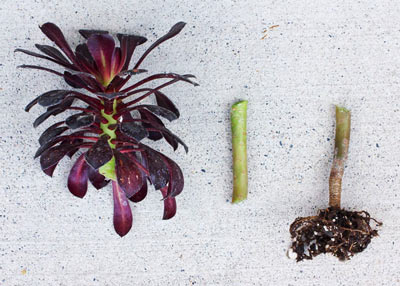

sprinkle the cut with activated or charcoal and protect it from the access of bright light in order to avoid the death of the mother flower;- prepare a substrate of leafy earth and sand in a 1: 2 ratio;
- having placed a stalk in a container with soil mixture, water well.
After two weeks, roots will appear.
Transfer
Mature aeoniums are transplanted every 2-3 years, young plants are transplanted annually. If roots stick out from the ground, then it's time for a transplant. A clay pot is best suited.
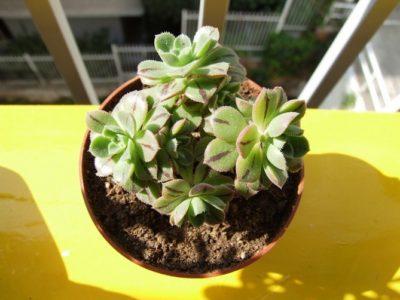

The composition of the soil should be the same, since the plant does not like the stress associated with changing soil.
For this process, the best time is March-April. If carried out later, then only during the growing season. In winter, if absolutely necessary.
It is recommended to examine the roots during transplantation., if there are rotten ones, they should be removed, and the place of the cut should be sprinkled with charcoal.
Before planting, rinse the pot, fill in the drainage layer, then the prepared soil and make a hole, then carefully transfer the plant.
Proper watering
Aeoniums belonging to succulents suffer from an excess of water entering the soil: the fleshy leaves begin to fade. This is what many flower growers like. The plant can be without watering for a long time, when the owners often leave home.
In winter, watering is extremely rare, no more than 2 times a month. But if the apartment is dry and hot, then it is necessary to ensure that the substrate does not completely dry out. You do not need to spray the leaves; you can wipe the accumulating dust from them with a damp fluffy brush.
Together with water, mineral fertilizers can also be applied to the soil, repeating the procedure once a month. And the substrate itself is best composed of equal parts:
- leafy land;
- sand;
- turf land;
- peat;
- charcoal (prevents root rot and other diseases).
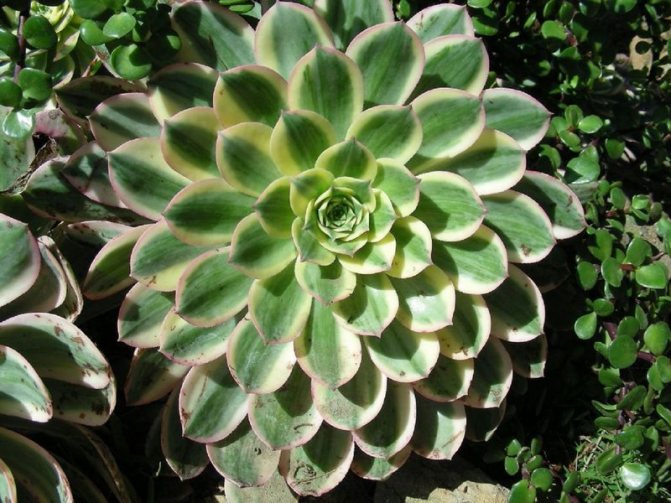

Every 2-3 years, the plant can be replanted, and annually it is enough to remove only 1-2 cm of the topsoil. At the bottom in pots, there must be drainage at least 5 cm high. Getting seeds at home is difficult, therefore reproduction is carried out by rooting cuttings cut from the apical part.From different types of aeoniums, you can create a unique collection by choosing only succulents or adding other plants to the composition.
How does it take care of a tree succulent?
The most common aeonium is considered to be tree-like. It grows as a small, weakly branching bush. Succulent blooms with small white, red or yellow flowers. At the ends of the stems there are rosettes with dense leaves. In nature, the height reaches up to 3 meters, in room conditions they grow no more than a meter.
With proper and competent cultivation, the flower grows quickly. Several new outlets are formed during the year. The plant lives for many years.
Basic rules for caring for a tree-like aeonium at home:
- The succulent loves light, it needs the sun even in winter.
Unlike other aeonium species, it does not like phyto-lighting, so it is best to place it on a southern or southeastern window sill. But by no means to the north side. - In summer, the optimum temperature for him is 23-25 degrees, in winter 10-12 degrees. If it is not possible to create cool conditions, then the number of new outlets is sharply reduced and flowering stops. In the open air, it should be kept under a canopy, as it does not tolerate dampness and rain.
- It tolerates dry air well, so it does not need to be moved to another place with hot batteries.
- In the summer they water only if the soil is very dry once a week, in winter it is even less. Watered gently around the edges, without falling on the leaves and stems, otherwise water stagnation may occur, which means root rot. Spraying is not required. If dust appears, it is better to wipe it off with a damp cloth.
- In winter, the tree-like aeonium is not fertilized. During the growing season, they are fed once every 2-3 weeks with fertilizers for cacti and other succulents. In no case should nitrogen fertilizers be used.
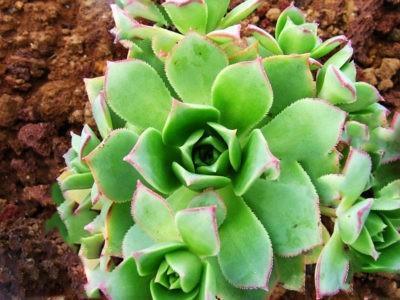

Young plants are transplanted annually, adults no more than 1 time in 3 years. The pot should be earthenware and 3 cm wider than the previous one. For transplanting, you can use cactus soil or mix in equal proportions sand, turf, leafy soil and peat. Charcoal is added to the soil for better growth. And also the first layer should be drainage so that the roots do not rot.- Aeonium tree-like is propagated by sowing seeds and cuttings. The seeds are simply scattered, sprayed with a spray bottle and covered with foil or glass. They grow quickly at a temperature of 20 degrees. For cuttings, cut the upper part of the stem. The cut is rubbed with activated carbon and dried. They are planted in moist soil. Roots are formed in 11-14 days.
Caring for a tree-like aeonium will not be difficult if you follow all the rules.
Species diversity
The genus of aeonium is represented by more than 70 varieties and varietiesthat are very different from each other. Many species are suitable for growing in urban apartments.
The species diversity of the plant provides the future owner with a wide choice and the opportunity to create a succulent mix using only representatives of one genus.
- Eonium noble - a species with a short stem, covered with juicy wide leaves in the form of grooves, curved along the edges. Olive leaf plates form a rosette with a diameter of up to 50 cm. During flowering, an umbrella inflorescence is formed on a peduncle up to 50 cm long, consisting of copper-scarlet flowers.
- Eonium home - a variety, which is a small tree 30 cm high with a large number of densely spaced branches. Shoots extending to the sides of the woody trunk bend towards the top. Shovel-shaped leaf plates of dark green color have a slight bend inward. When flowering, the succulent produces a peduncle up to 20 cm in length with an inflorescence of 7 yellow flowers.
- Eonium Burchard - succulent with a glossy central shoot of a brown shade.Fleshy sessile leaves, painted in marsh, yellow and orange tones, form rosettes with a diameter of 10 cm.
- Eonium decorative - a miniature tree up to half a meter tall with a large number of loosely growing branches. Rough shoots cover in the lower part clear traces in the form of rhombuses from fallen leaves. The burgundy leaf plates of the broad-lanceolate form, forming a spherical rosette, fold along the central vein.
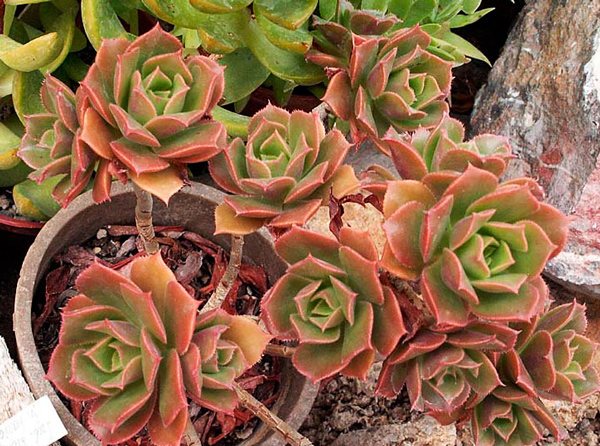

This color comes over time: first, a young specimen with green leaves develops a red canvas, which expands over the years. The species blooms with pale pink flowers.
- Eonium canary - a perennial with a very short stem, in which leaf rosettes in the first few years of growth are formed near the ground. Large sessile leaves have wide spatulate tops with a rounding and narrowed bases.
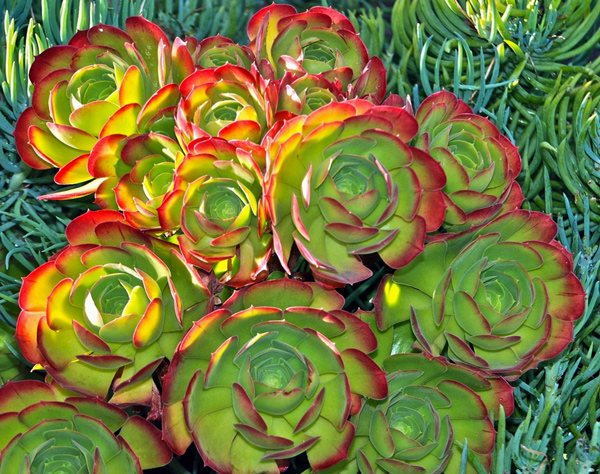

The covering of light green foliage with a gray tint is represented by thin short gray hairs. The diameter of the rosette of an adult specimen, from which a peduncle of 80 cm with pale green flowers develops, can reach half a meter.
- Aeonium virginian - stemless variety, forming many rosettes of rich green leaves with a pale pink base, exuding subtle notes of balm. Growing, the plant resembles a pillow due to the velvety coating of the leaves, which at a young age have wavy edges. The flowers are colored lemon yellow.
- Eonium wavy - a powerful succulent with a silvery trunk covered with brownish scars and a small number of shoots, on the tops of which there are dense dark green rosettes. Spatulate glossy leaves, narrowed at the base, widen to a rounded wavy edge. Wide pyramidal inflorescences are composed of dark yellow flowers.
- Aeonium treelike - a species with a slightly branched stem, lignified at the base. Dense rosettes, formed by spatula-like light green leaves with whitish cilia along the edges, are located at the tops of the shoots. The maximum length of the peduncle, topped with a yellow inflorescence with ebb, is 30 cm.
- Eonium balsamic - the species owes its name to its aroma .. The plant stands out for very large shoots, on the tops of which are concave rosettes.
- Eonium golden - a perennial with a branched stem. Shoots grow straight, drooping towards the end. The rosettes are formed from narrow spatula-like leaves of yellow-green color with a red stripe in the center and edge of the plate. Succulent blooms golden.
- Aeonium Lindley - a species with a lignified stem at the base, from which many thin curved branches of a brown shade depart. Shovel-shaped dark green glossy leaves with hardly distinguishable villi, collected in small dense rosettes at the tops of the shoots, have subtle aromatic notes. A very beautiful aeonium, the flowering of which is noted when the flowers bloom with a golden hue.
- Aeonium layered - a species with a shortened stem, crowned with a dense flat rosette with a diameter of half a meter. Shovel-shaped light green leaf plates have a narrow base and an extended edge, framed by white cilia. Inflorescence in the form of a pyramidal panicle consists of yellow flowers.
- Eonium Haworth - branched succulent up to 30 cm in height, the shoots of which are formed directly under the outlet. After a while, aerial roots form on them. Thick gray-green leaves, bordered with cilia and a red stripe, are collected in a dense rosette. Hanging inflorescences consist of 7 pink or yellow flowers. The species is also known as aeonium Kiwi.
- Eonium Schwarzkopf - the artificially bred species is distinguished by narrow maroon leaves with a green base.
- Aeonium disc-shaped or tiered - a view in which a flat rosette is formed, resembling a plate. The tiled leaves are framed with cilia. The half-meter peduncle is crowned with a yellow inflorescence.
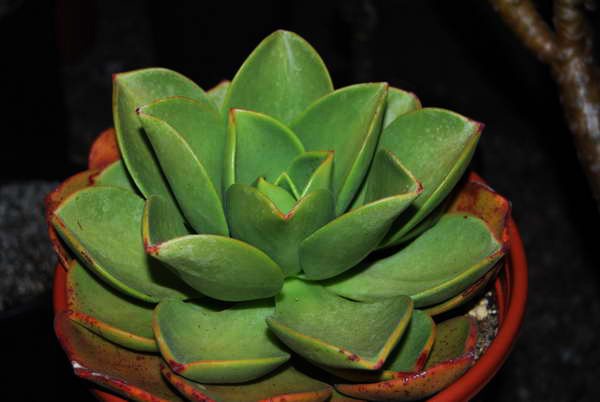

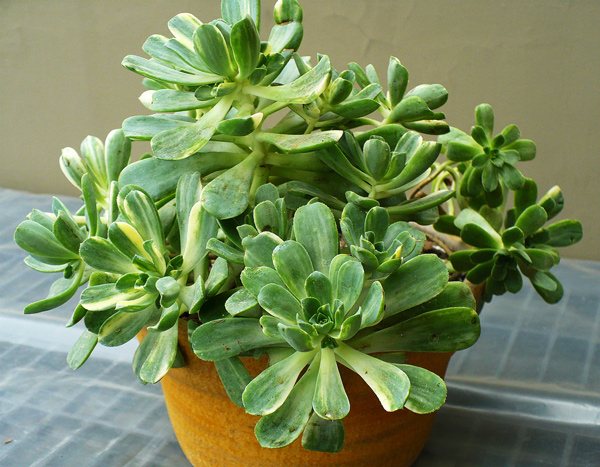

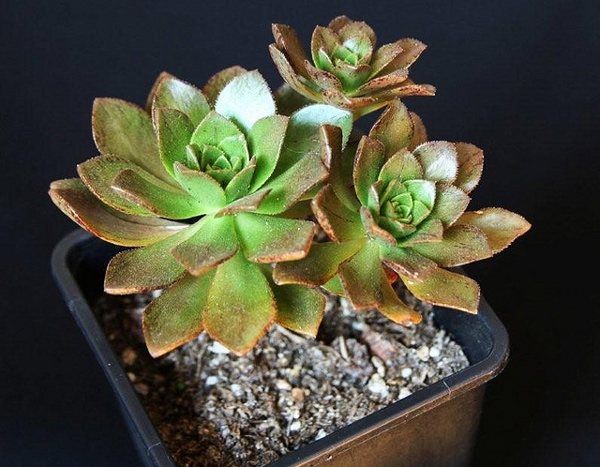

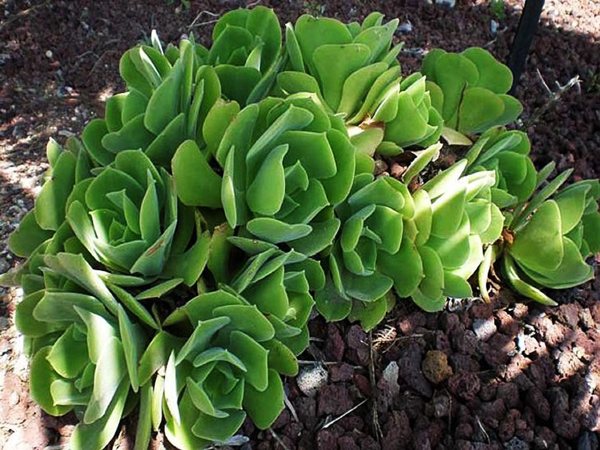

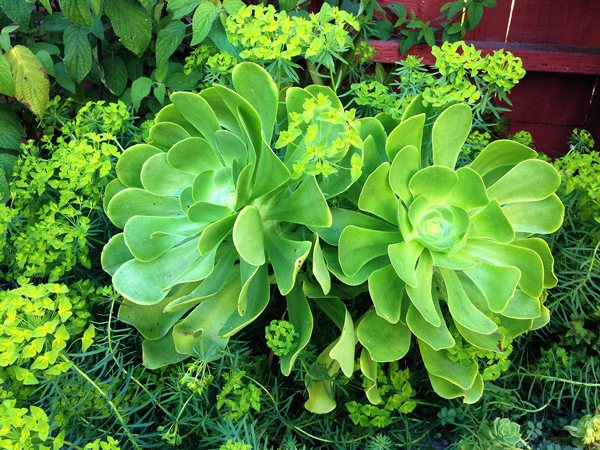

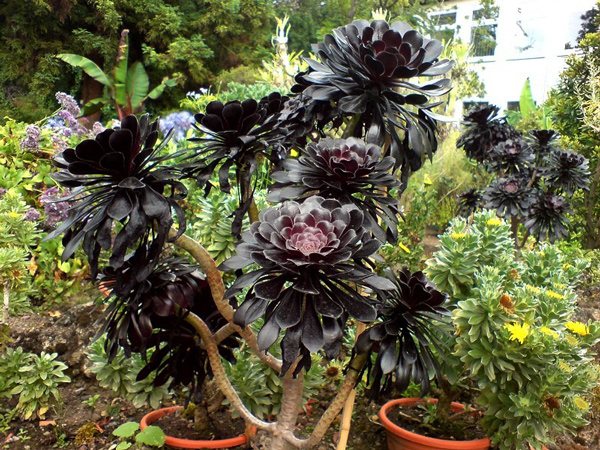



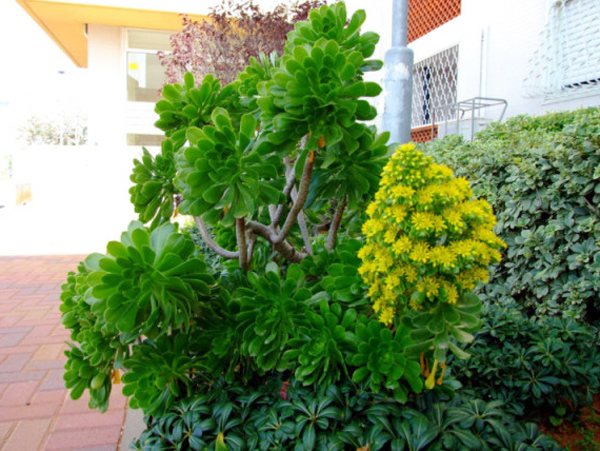

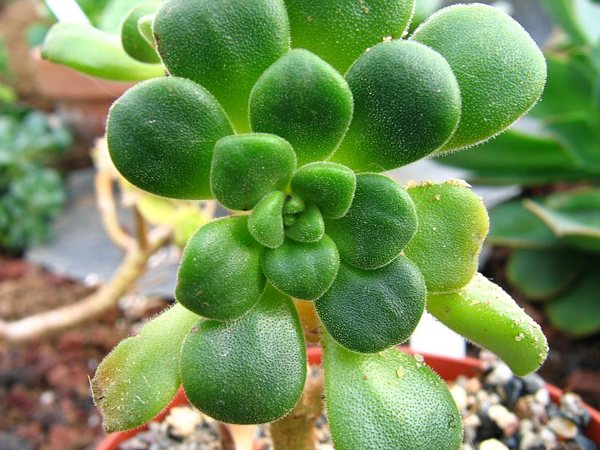

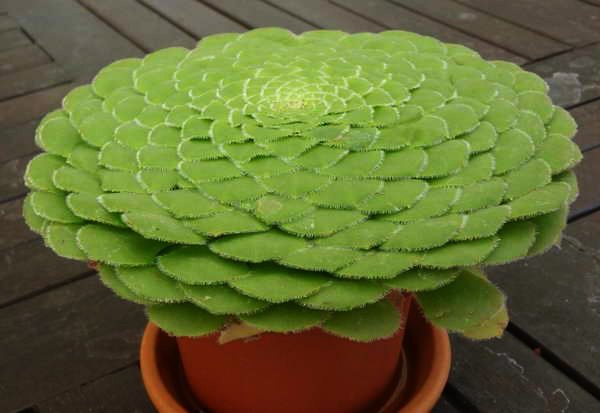

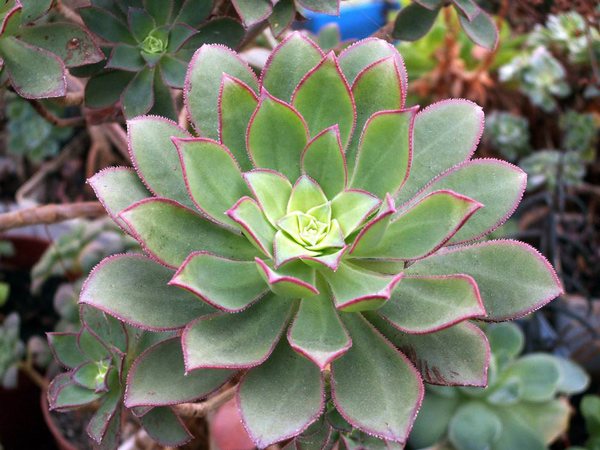

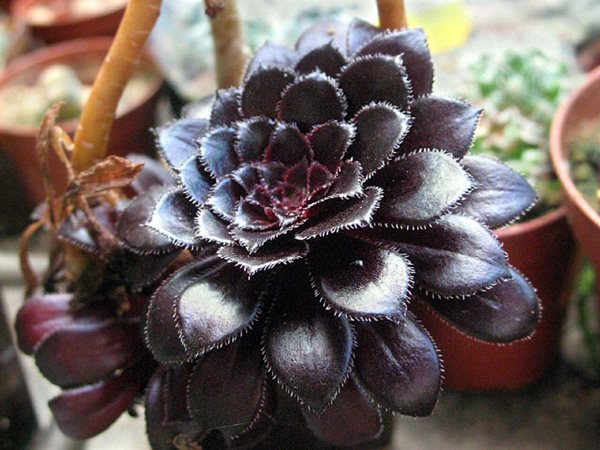

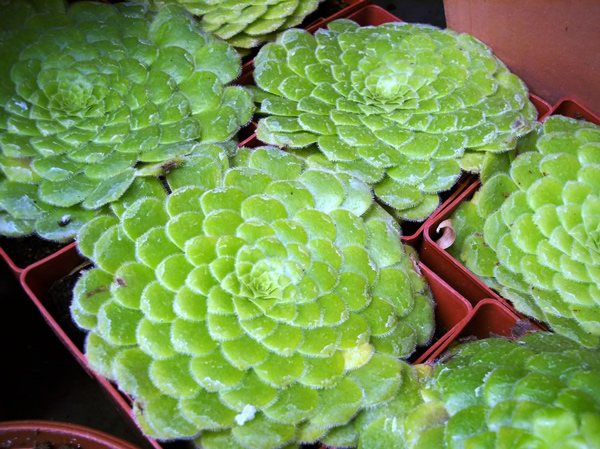

Diseases and pests
Eonium rarely gets sick and is attacked by pests. The most common problem in the cultivation of aeonium is the defeat of mealy herbs.... They inject substances and suck out the juice from the succulent, which inhibits the growth of the flower and leads to death. The presence of pests gives out a white waxy coating. And also rarely occurs the defeat of root worms and spider mites.
If the flower stands in an open area, then weevils and aphids can attack it.
To prevent infection, you need to inspect new acquisitions, remove dried leaves, and sometimes arrange a hot shower.
If they do appear, the leaves are wiped with soapy water or alcohol. And also sprayed with tobacco smoke. If the infection is strong, then insecticidal preparations are used, for example, karbofos.
Various fungal diseases can also appear on plants.... Most often, they occur with improper watering and care. For treatment, fungicidal preparations are used.
Biological species
Tuberous begonia all about planting a flower and care features
In the Tolstyankov family, there are almost 90 different types of aeonium. Some of them are ordinary green plants, while others are original representatives of the flora, striking with their unusual parts.
The most famous types include:
- Aeonium nobile (Aeonium Noble) is a succulent for home cultivation, which has curving, juicy olive-colored leaf plates that form chic rosettes up to half a meter in diameter.
- Aeonium arboreum (Eonium tree) is a shrub that produces rare shoots that quickly lignify near the base. The rosettes are dense, formed from brown and light green leaves, are formed at the very end parts of the shoots and do not exceed 25 cm in diameter.
- Aeonium undulatum (Eonium Wavy) is a powerful and effective plant, on the stem of which there are large shoots with wide rosettes and thick scars on the entire surface of silvery stems.
- Eonium Schwarzkopf - at the ends of the shoots, erect peduncles bloom, which branch out to the sides. The inflorescences are pink or bright yellow, and the shape of the plant resembles a wide plate with a small tree in the center.
- Aeonium lindleyi (Lindley's Eonium) is a compact but actively branching bush with rounded, pubescent leaves. They are slightly sticky to the touch and emit a specific, pleasant aroma.
- Aeonium tabuliforme (Eonium layered) is a stunted plant with an almost flat rosette of leaves, the arrangement of which resembles the surface of tiles, and thin cilia whiten at their edges. The stem of this species is practically invisible, and the bush itself is striking in its almost absolute symmetry.
Each of the species has insignificant characteristics, but it is these little things that allow them to be recognized and create a variety of collections in the house or in garden plots.
Difficulties of content
Eonium is not considered a capricious plant, but problems may appear that need to be eliminated for the further development and growth of the plant:
- Decay of roots... This happens with improper watering and strong soil moisture. Therefore, at the first sign, the plant is transplanted. The roots are thoroughly washed, cleaned of rot and sprayed with a solution of potassium permanganate.
- Falling leaves, curvature of stems... In winter, it indicates an excess of overflow. In the summer about insufficient lighting. The plant is rearranged to a brighter place. And, if necessary, rotate for uniform growth.
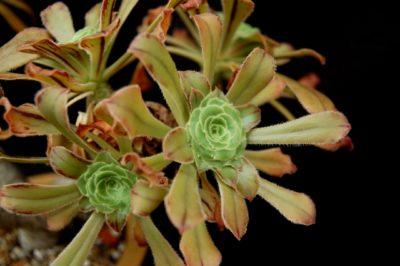

The appearance of brown spots in summer... Indicates a lack of moisture. It is necessary to water the plant or arrange a warm shower.- Withered wilted leaves... It means that the plant has been watered too much, it is necessary to spill the fungicide Previkur or the biological product Fitosporin.
- Loose rosette with small leaves... Indicates that the plant urgently needs to be transplanted, as there is not enough space for it.
- Rosette leaves begin to turn yellow and rot from the middle... This means that moisture stagnates in the middle. Healthy parts of aeonium can be used for cuttings.
Growing and care
First of all, it is worth remembering that aeoniums need good lighting, but hardly tolerate moisture. With moderate watering, these succulents feel much more comfortable than with abundant moisture.
Compact flowers with original details will grow effortlessly even for inexperienced growers
One of the main rules is that the plant loves attention. Aeoniums are simply created to delight and delight others.
Leaves with a variegated color, it is advisable to slightly shade, and bright green - to be placed on sunny windowsills. With a lack of light, the flowers lose their attractiveness, the leaves become small, the rosettes become less spectacular. The stems are bent, gradually elongated, which does not look very aesthetically pleasing anymore.
A special rule in the care of the aeonium is no additional illumination with the help of indoor appliances. They only need sunlight and react negatively to any lamps. The recommended temperature is about 25 degrees, but the plant tolerates heat well, as well as wintering in indoor conditions.
Aeonium virgineum
Stemless or short-stemmed, developing many leaf rosettes, resulting in large pillow-like groups. The leaves are velveteen-pubescent, bright green, pale pink at the base with a pleasant smell of balm, collected in a loose rosette. Young leaves with a wavy edge. The inflorescence in natural conditions reaches 1 m in height. Flowers 6-9-membered, lemon yellow. Homeland - Canary Islands (Gran Canaria).
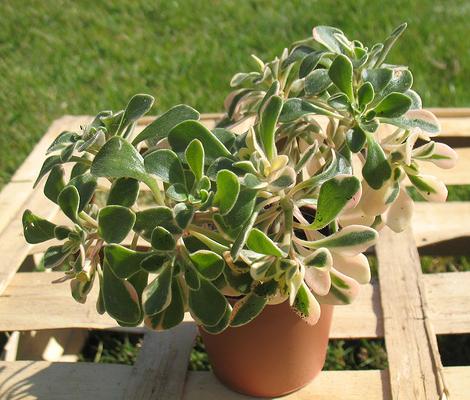

E. home
Success secrets
Young Aeoniums should be moved to a new container annually, mature once every two to three years. In order not to injure the roots, it is better to use the transshipment method. In this case, the new container should not be much larger than the previous pot.
During the intensive growth of the plant, it is important to let the earthy coma dry slightly for the next watering. Do not allow moisture to accumulate at the base of the leaf outlets due to watering or spraying.
The decorativeness of a plant with bare stems is restored by cuttings.
Varieties and varieties of aeonium treelike
The plant Aeonium arboreum has several natural forms and varieties bred by breeders that are worthy of the attention of domestic flower growers.
Aeonium arboreum var. albovariegatum is a variety with white foliage edging.
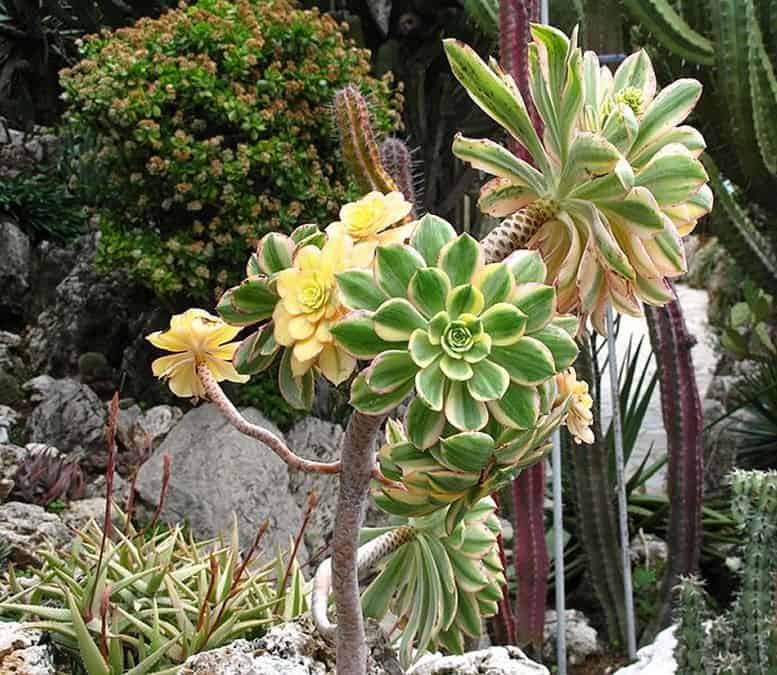

Aeonium arboreum var. albovariegatum
Aeonium arboreum var. atropurpureum is a shrub with long curving stems, at the top of which there are large rosettes of dark purple leaves.
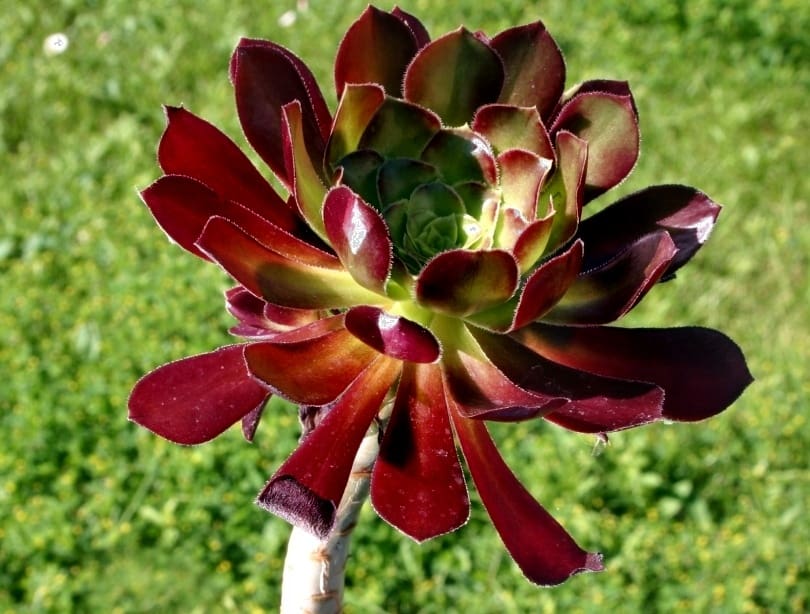

Aeonium arboreum var. atropurpureum
Aeonium arboreum atropurpureum f. cristatum is a crested form with cheerful purple leaf rosettes at the ends of the branches.
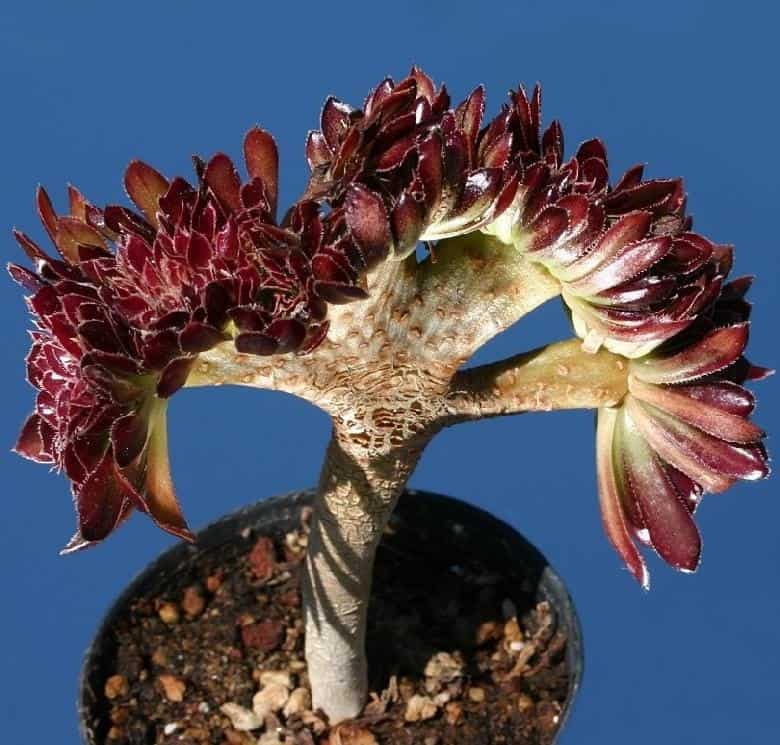

Aeonium arboreum atropurpureum f. cristatum
Aeonium arboreum atropurpureum cv. Schwarzkopf (Zwartkop) is a Schwarzkopf variety with almost black foliage. The most popular plant of all the Aeoniums, which is popularly called the Black Head, Black Aeonium or Black Rose.
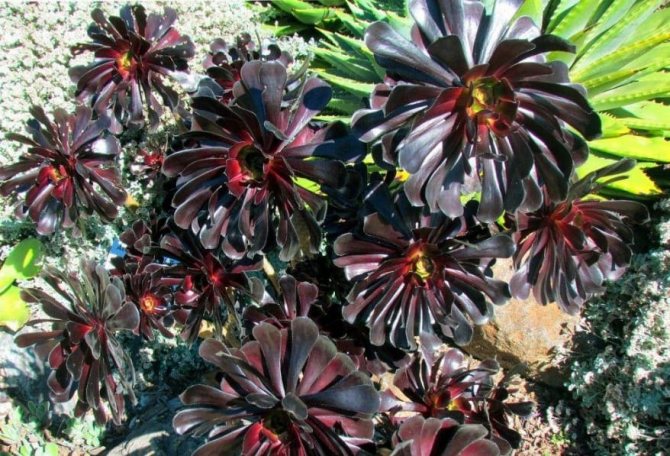

Aeonium arboreum atropurpureum cv. Schwarzkopf (Zwartkop)
Aeonium arboreum subs. holochrysum - known as aeonium tree-like golden. The leaves look very variegated - in the very center and along the edge of the leaf there is a purple stripe against the background of a yellow-green background.
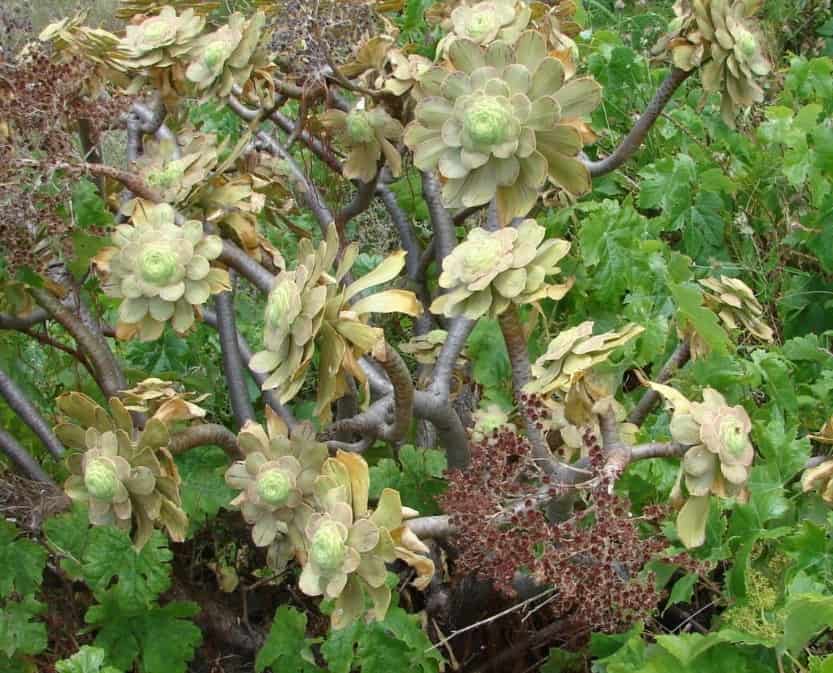

Aeonium arboreum subs. holochrysum
Aeonium arboreum var. rubrolineatum - during the winter months, the plant stands with normal green leaves, but as soon as it receives more light with the arrival of spring, its foliage transforms - it becomes a yellow-brown hue with maroon stripes and markings on each plate.
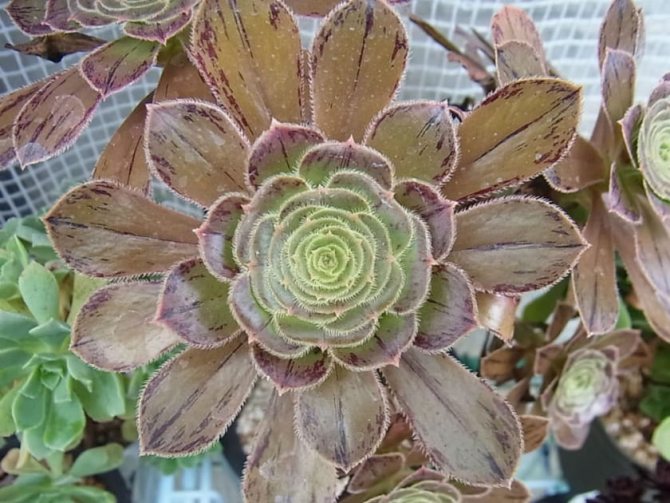

Aeonium arboreum var. rubrolineatum
Aeonium arboreum var. luteovariegatum - has pale leaves with a wide creamy yellow stripe along the edge. Often the leaf blades in the center of the rosette are completely light yellowish.
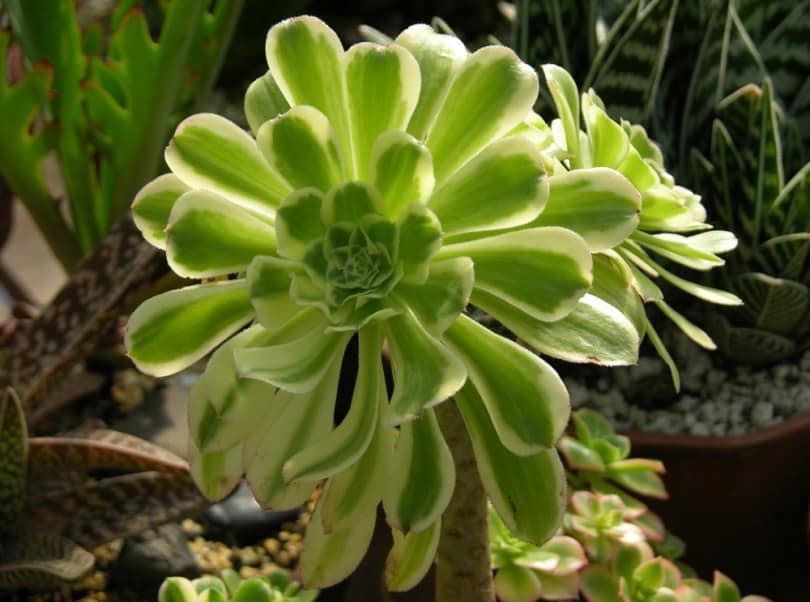

Aeonium arboreum var. luteovariegatum
Aeonium lindleyi
Otherwise, tenacious... Very similar to Aichryson, but Eonium Lindley has more pronounced succulence, thick leaves (see photo on the page). Low ornamental deciduous shrub with fragrant flowers. 15-30 cm high with numerous thin curved branches, with brown bark cracking along the length. There are small leaf rosettes at the ends of the branches. The leaves are small, spatulate, very thick, 2.5 cm long, 5-6 mm thick, bright green, shiny, covered with short, barely visible hairs.Apical inflorescence. Flowers 8-9-membered, golden yellow. Homeland - the Canary Islands (Tenerife island), where this species grows on the hot slopes of the rocks.
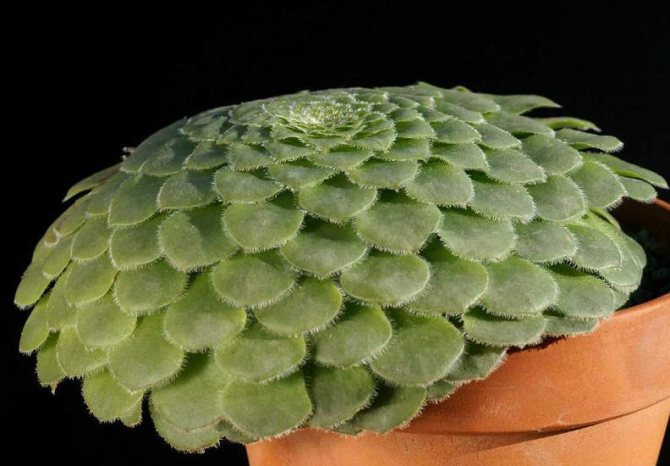

Aeonium tiered
Possible problems
In the summer (especially when the aeonium is taken out of the closed space of the room), aphids and weevils can attack the plant. It is advisable to notice this attack in time and wipe the leaves several times. You can - with kerosene or other chemicals specifically designed to prevent the development of pests.
In rare cases, such a phenomenon can occur with the eonyum: the leaves will begin to shrink, shrink, change their shape. This means that the plant is dry or exposed to temperatures that are too high for it. Adjust the care and the eonymum will return to normal.
Using aeonium
Aeonium is often used to decorate houses. In warm regions, where in winter the temperature does not drop below + 5 ° C, aeoniums are used in landscape design, to decorate flower beds and gardens.
Another important feature of the plant is its medicinal properties. For this, he is often called a plant healer or surgeon. The fleshy leaves and the juice squeezed out of them are used externally to fight inflammation, abscesses, herpes, acne. The plant tissues contain antiseptics that help to cope with harmful bacteria. Products based on eonium juice also save from burns, abrasions and relieve itching from insect bites.
Growing aeonium from seeds
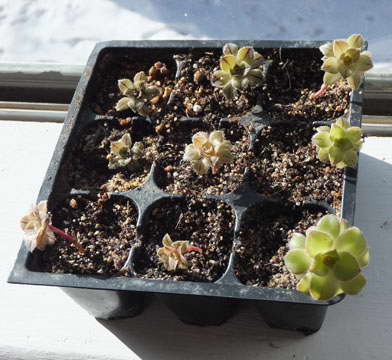

Seed aeonium photo of seedlings
- It is enough to sprinkle small seeds over the ground, spray with water from a spray bottle, cover with foil.
- If the temperature is maintained at 20 ° C, the seeds will quickly germinate, giving friendly sprouts, which must be grown, individually planted in separate cups.
Aeonium disc-shaped, or plate-shaped, tiered (Aeonium tabuliforme)
Perennial herbaceous with a short stem bearing a dense rosette of leaves. The leaves are arranged tightly, like a tile, in one plane, like a plate, 6-16 cm long, 2.5-4 cm wide, light green, glabrous, with long white hairs along the edges. The number of leaves in a rosette can reach 200. Inflorescence is 30-60 cm long. Flowers 7-9-membered (usually 8-membered), light yellow. An amazing picture is presented by these flat rosettes, stacked of leaves densely, like a tile, found on top of each other. The diameter of such plates can be up to 30 cm. After 2-3 years, the center of the outlet begins to rise, stretch, and a branched inflorescence is formed. After flowering, the plant dies. The only way to support this species is by sowing seeds. Homeland - Canary Islands (Tenerife island), where the species grows on coastal rocks at an altitude of 1000 m above sea level.
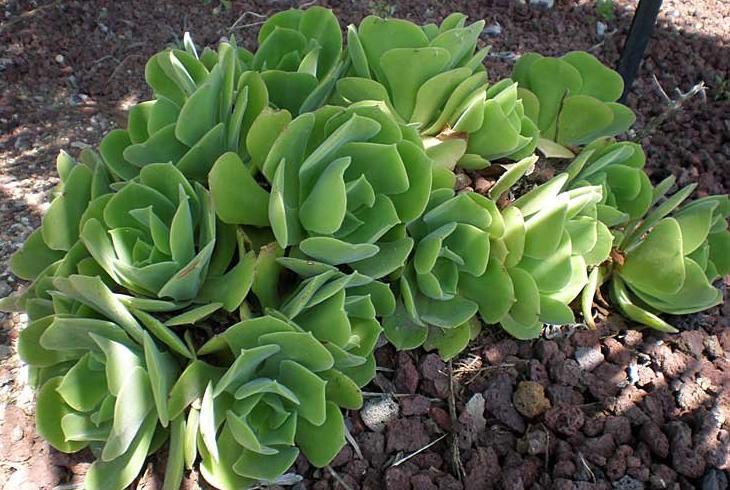

E. virginsky E. noble
Features of the content of aeonium treelike
Succulent lighting requirements are high. Throughout the year, the duration of daylight hours for him should be at least 10-12 hours, even in the winter period of rest. If this condition is not met, the stems stretch out, the leaves also, the rosette becomes loose and loses its density. In variegated forms, the pattern on the leaf blades is lost. There is only one way out - to illuminate artificially using phytolamps.
In summer, the Eonium tree flower is taken out into the garden, the plant responds well to such a movement. In the fresh air, it is not afraid of direct sunlight and visibly revives.
A high ambient temperature is not suitable for a plant; it develops better with a relatively cool content. In summer, the succulent perceives well the microclimate in a room with a thermometer reading from 18 to 23 degrees above zero. With hotter air, ventilation will be required in the morning hours, when the outside air is fresh after the night.
In winter, the aeonium has a pronounced rest period. At this time, it is rarely watered, not fed and the temperature in the room is maintained at about 8-12 degrees Celsius.If the building is warmer, the plant sheds its leaves and remains with only a few rosettes at the very top of the stems. It looks quite a bit decorative and is only suitable for grafting.
